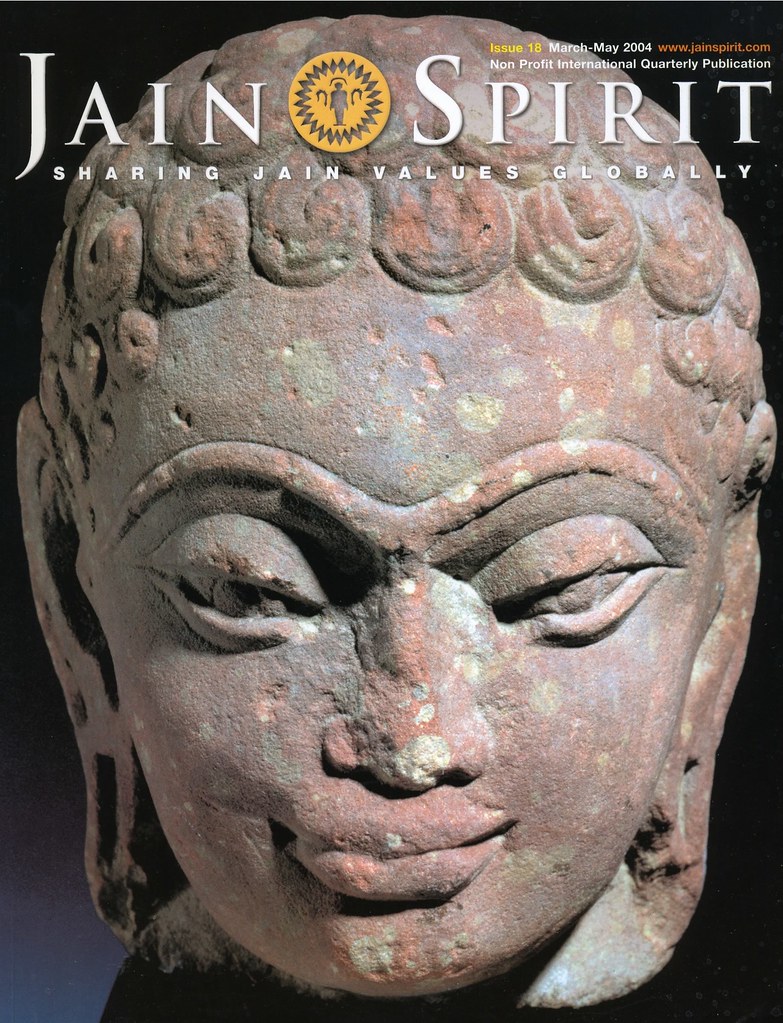 Jain Spirit magazine - A non-profit International Quarterly Publication - #18 (2004-2). Photo - Bridgeman Art Library: Jain Head, 6th century AD, Mathura region, India.
Jain Spirit magazine - A non-profit International Quarterly Publication - #18 (2004-2). Photo - Bridgeman Art Library: Jain Head, 6th century AD, Mathura region, India.Acharya Mahaprajna - Jain Muni Receives Indira Gandhi National Integration Award
 Jain Muni Receives Indira Gandhi National Integration Award in 2004
Jain Muni Receives Indira Gandhi National Integration Award in 2004The Venerable Acharya Mahaprajna, the eighty-three year old Supreme Head of the Terapanthi sect of Shvetambara Jainism, has received one of India's highest honours: the Indira Gandhi Award for National Integration. This achievement crowns a long career as a Jain muni (monk) living out the ideal of ahimsa and combining contemplation with social engagement. Acharya Mahaprajna has written a plethora of books and articles on non-violence and conflict resolution. He has also been active in organising training programmes in applying the principles of Jainism - and ahimsa in particular - to social, political and economic questions.
Acharya Mahaprajna was born on 14 July 1920, in the village of Tamkor, in Rajasthan. He became a monk at the age of ten and showed himself proficient as a scholar of Sanskrit and Prakrit literature as well as Rajasthani and Hindi. As a young monk, he immersed himself in the study of Ayurveda, Western science, politics and economics, anticipating recent interest in the connections between spirituality and science. His mentor was Acharya Shri Tulsi, who worked with him in establishing the Anuvrat movement among lay Jains. The Terapanthi sect of Shvetambara Jainism is noted for its emphasis on the Anuvratas, or 'lesser vows' undertaken by the laity; monks and nuns undertake the more rigorous versions, called the Mahavratas, or higher vows. The Anuvratas consist of five vows: ahimsa or non-violence, truthfulness, avoidance of sexual excess, and limiting possessions or avoidance of greed.
As well as a man of action, Acharya Mahaprajna is a writer and thinker, who has produced over one hundred books. In them he explains Jainism in ways with which a lay audience, Jain and non-Jain, can identify with and apply to the choices they face in their own lives. In particular, he regards the Jain ethos of anekantvada as having much to offer to the wider world outside Jainism. He believes that it will have a transforming effect on politics, economics, international relations and -crucial in today's world: conflict resolution. This is because anekantvada, or many-sidedness, encourages us to view issues from a variety of perspectives, to understand the viewpoints of others without abandoning one's own principles. It involves thinking around problems rather than drawing doctrinaire conclusions that are only one-sided. This is why Acharya Mahaprajna describes anekantvada as 'the third eye': it represents a higher form of consciousness that embraces the whole truth, not just a part of it. It is through this approach, he believes, that national integration can be achieved in a complex, diverse society like India. This approach can also benefit an increasingly interdependent world, in which the need for cultures and faiths to understand each other has never been greater.
One of the main features of Acharya Mahaprajna's world view is the emphasis on engagement with society and a strong concern for social justice. This does not mean compromising on Jain values. On the contrary, it means practising Jainism as a living religion, which can deliver positive benefits to individuals and to the wider human community. Jainism is a transcendent religion, rising above passions and enabling the individual soul to escape the cycle of birth, death and rebirth. However, to transcend the world, one must first understand and try to improve it. Eastern philosophies, including Jainism, have been criticised for their emphasis on the otherworldly, as opposed to human needs and human rights. Conversely, Western thought has often been limited by its emphasis on the material at the expense of the spiritual; the immediate at the expense of the transcendent.
For Acharya Mahaprajna both elements, spiritual and material, are essential for human fulfilment. The spiritual and meditative dimension should be balanced by a practical concern for one's fellow creatures. The pursuit of material needs, for oneself and others, should be balanced by the values of personal restraint and spiritual endeavour. The Jain principle of aparigraha balances spiritual and material values by asking us to live within limits rather than squander the Earth's resources. Over-consumption is a form of himsa to oneself as well as to the planet, as is violence of any kind. With this in mind, Acharya Mahaprajna has organised programmes on peace and non-violence in India and around the world for politicians, non-governmental organisations, fellow-Jains and members of other faith communities. In this way, Acharya Mahaprajna is in the reforming tradition within Eastern religion, along with Hindu spiritual leaders such as Sri Aurobindo and Swami Vivekananda, who gave the Vedic tradition a new dynamism and reconnected it with wider social concerns. His balance of spiritual and material needs should also appeal to the West where, since the time of Christ, spiritual thinkers have argued that humans 'cannot live on bread alone'. Acharya Mahaprajna's interpretation of Jain teachings accords well with the trend towards social engagement among Buddhists, East and West, and with strong Islamic and Jewish traditions for social reform. Not surprisingly therefore, Acharya Mahaprajna has been invited to Buddhist monasteries as well as temples, churches and mosques, to discuss issues relating to ahimsa, world peace and interfaith dialogue.
The Anuvrat movement stresses the responsibility of lay Jains to obey these vows not passively, but to apply them actively so that they make a difference to the world around them. As such, the sect's emphasis has been on practice rather than ritual, on the importance of the individual and on equality between the lay and ascetic aspects of Jainism. Like Acharya Shree Tulsi before him, Acharya Mahaprajna stresses the need to transcend not only the lay/ascetic division, but also any other divisive criteria such as religious or social background, gender or race. Thus his teaching is, at one level, a 'back to basics' Jainism, but it is also universalist and so a highly modern interpretation of ancient wisdom.
Mahaprajna has developed a 'science of living', with three underlying goals:
- development of a healthy personality: the integration of the physical, intellectual, spiritual and emotional aspects of the human character;
- evolution of a new world, free from violence, exploitation and unrestrained conduct;
- evolution of a new humanity, in which the scientific-rational and the spiritual world views are integrated
These sound like highly ambitious, almost grandiloquent goals. In a sense they are, but with each of these aims the starting point is the individual and the basic changes he or she can make in daily life, which together add up to something larger. Although Acharya Mahaprajna is perhaps best known for his social and - in the broadest sense -political work, he is as focused on the inner life as any other Jain muni. Indeed, one of his many honorific titles is: Retriever of Jain Yoga. This was conferred on Mahaprajna for his revival of Preksha Dhyana, a form of meditation rooted in Jain culture. He regards meditation highly important to individuals and society. Individuals use it to pursue truth and transcend the ego. This in turn encourages good conduct, sociability and peace.
Acharya Mahaprajna has achieved much in his life, and for a man of his years displays immense energy and zest. He has walked over 100,000 miles as a monk and is now in the third year of an Ahimsa Yatra, or walk for non-violence, during which he has met many prominent figures in Indian public life (see World News section). His award raises the profile of Jain teachings and so is being celebrated by Jains of all schools of thought, in India and beyond.